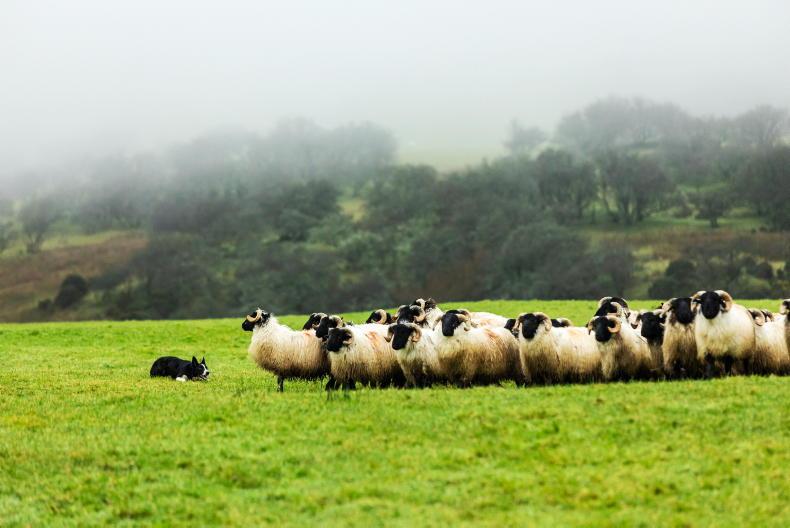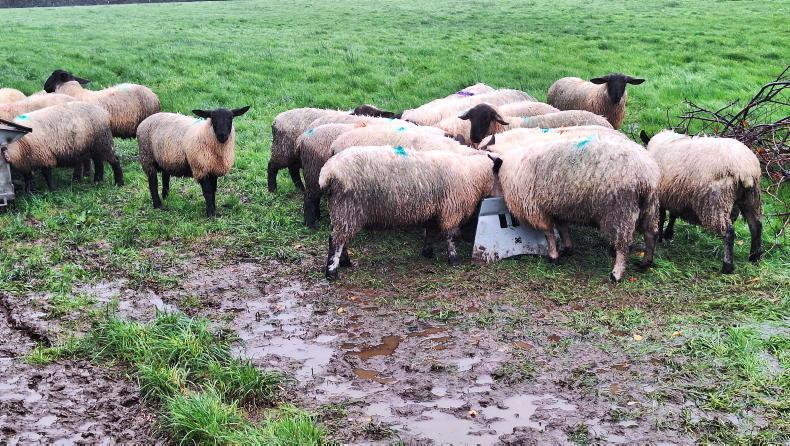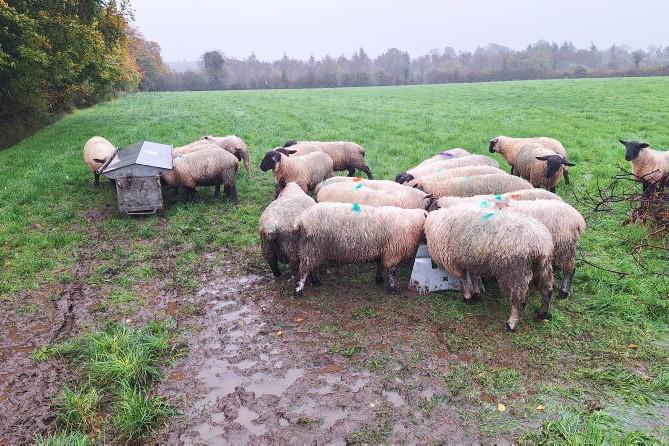I got on well last year purchasing light hill lambs, storing them over the winter and then finishing intensively. I tried finishing outdoors but given the weather was forced indoors. I was told that if I had shorn the lambs, they would have performed better. Is this the case?
Extensive research has been carried out in Teagasc Athenry exploring the benefits of shearing lambs. Results from trials undertaken show no significant effect from shearing lambs on average daily gain, feed intake and feed conversion efficiency of carcase weight.
The only significant difference was the killout, which was 1.2% higher in shorn lambs, but this can be attributed to the lower drafting weight of lambs minus the weight of the fleece.
The significant benefit that shearing does have is in keeping lambs cleaner or where grazed outdoors in fields with hedgerows and briars, it reduces the risk of lambs getting caught. Where shearing lambs, research has also shown that about four weeks’ wool regrowth is required before slaughter to allow lambs to be re-shorn, if necessary, before slaughter to comply with the clean livestock policy.
I am running tight on grass and am increasing the meal for ram lambs feeding daily in troughs and also topping up creep feeders. Lambs are not on ad lib yet but are not far off it. Lambs are outdoors at present, but I am wondering if I am better leaving them out or should I house them?
Presuming lambs are tightened up and not eating into grass reserves, there are no negatives to leaving them outdoors once the weather is relatively good. If, however, the weather deteriorates and ground conditions worsen, then performance of lambs will be typically higher indoors once lambs have access to good environmental conditions – plenty of space to eat, not overstocked, etc.
The other factor that needs to be taken into account is straw supply, if housing lambs on straw bedding.
I have lambs coming into the shed to eat from creep feeders and returning to a small field adjacent to the shed as they please while weather allows. Lambs are on feed about three weeks and doing pretty well or at least they seem to be. The majority of grass is grazed in the field. Do I need to start supplementing with forage or will they be OK without it? Also, is a 14% ration high enough in protein?
The intake of concentrates will typically increase as forage intake reduces. In theory, roughage can be cut altogether if the crude fibre content of the concentrate offered is in excess of 7%.
There is generally no need to offer roughage as long as lambs have some access to grazed grass, even if at low levels.
The one area to watch is if lambs are being housed permanently to allow lambs to transition to their new environment. In such a scenario, offering a source of roughage for the final few days pre-housing will help lambs to adjust but it is not critical.
Some findings from the lamb finishing trials in Teagasc Athenry include a recommendation to offer lambs a small quantity of roughage.
Lambs in Athenry are allocated about 400g silage fresh weight with about half of this consumed.
There is merit in offering light lambs less than 35kg and growing a diet containing 13% to 14% crude protein
Lambs that were grazed on forage crops are typically offered an allocation of straw in covered hay racks.
With regards protein content, 14% will suffice. There is no merit in offering lambs forward, well-grown lambs receiving high quantities of concentrates a feed higher than 12% crude protein.
There is merit in offering light lambs less than 35kg and growing a diet containing 13% to 14% crude protein. Where lambs do not have access to grass then it is important to consider the crude protein content in forage and also volumes of concentrate being fed.
I read in the paper last year that you should include a mineral in feed when finishing ram lambs to help prevent kidney stones, but I cannot remember the name or advice. Could you repeat it again?
The advice where feeding male lambs for a significant period of time is to have feeds formulated to include ammonium chloride at an inclusion rate of 0.5%.
There should be no need for any additional mineral or vitamins, where a properly balanced concentrate feed is being offered to lambs.
I can purchase rolled barley and oats from a neighbour directly. The feed is good quality and is a lot lower in price than ration. Can I feed it directly to lambs and how much can I feed?
Both barley and oats can be fed to lambs to aid finishing, but careful management is needed as volumes offered increase.
The advice is generally not to go above 0.5kg fed, although this can be achieved with precise feeding management.
Splitting feeds into morning and evening feeds will also allow a higher level to be fed.
The other option is to feed grain along with a balanced ration to reduce the overall cost. This will decrease the risk of digestive upsets where feeding higher quantities of meal.
The other factor to take into account are palatability issues and getting lambs accustomed to feed where just feeding grain on its own. This is not generally an issue where lambs are accustomed to eating but can be an issue where trying to get lambs starting to eat.
Health concerns should be front
and centre
There are a number of health considerations that need to be accounted for when finishing lambs intensively.
Acidosis
Feeding management is critical. Where feed management and ration formulation are good, then the risk of acidosis is low.
Characteristic symptoms to watch out for are animals standing kicking their bellies or grinding their teeth and a grey scour occurring in tandem with reduced feed intakes.
Acidosis is not just a risk where lambs are not built up gradually to ad-lib meal feeding, it can also occur where there is a break in feed being offered or a significant change in the diet.
Clostridial disease/pneumonia
A significant change in a lamb’s environment or diet can act as a stressor in triggering an outbreak of clostridial disease or pneumonia.
A full course consisting of two vaccinations, administered as per manufacturers’ guidelines, is required to develop full immunity and is highly recommended for long-keep lambs.
A single administration of vaccine will build a level of immunity but for a short period of time.
Shy eaters
There will inevitably be shy eaters and lambs that will either refuse to eat or eat very low volumes. This tends to occur in hill lambs that have never been exposed to meals. Introducing meal feeding outdoors in advance of housing can help greatly in reducing issues.
It is important when lambs are housed to monitor closely as there may be lambs that need to be grouped together and in certain instances lambs that may need to be returned back outdoors.
Fluke and worms
Lambs suffering from a fluke or worm burden will perform much lower than healthy lambs.
Acute fluke is the greatest issue at this stage of the year and, as such, treatment options are more limited to products with longer withdrawal period. If this is a concern, then prompt treatment is important.
Following up on the health status of lambs slaughtered will deliver beneficial information.
Reader queries can be submitted to farmtechtalks@farmersjournal.ie or WhatsApp 086-836 6465 and we will endeavour to answer them in print, online or on the Farm Tech Talks weekly show.
Shearing lambs has been shown to have no effect on performance.A 12% crude protein diet is sufficient for finishing well-grown lambs.Health can have a big influence on performance.
I got on well last year purchasing light hill lambs, storing them over the winter and then finishing intensively. I tried finishing outdoors but given the weather was forced indoors. I was told that if I had shorn the lambs, they would have performed better. Is this the case?
Extensive research has been carried out in Teagasc Athenry exploring the benefits of shearing lambs. Results from trials undertaken show no significant effect from shearing lambs on average daily gain, feed intake and feed conversion efficiency of carcase weight.
The only significant difference was the killout, which was 1.2% higher in shorn lambs, but this can be attributed to the lower drafting weight of lambs minus the weight of the fleece.
The significant benefit that shearing does have is in keeping lambs cleaner or where grazed outdoors in fields with hedgerows and briars, it reduces the risk of lambs getting caught. Where shearing lambs, research has also shown that about four weeks’ wool regrowth is required before slaughter to allow lambs to be re-shorn, if necessary, before slaughter to comply with the clean livestock policy.
I am running tight on grass and am increasing the meal for ram lambs feeding daily in troughs and also topping up creep feeders. Lambs are not on ad lib yet but are not far off it. Lambs are outdoors at present, but I am wondering if I am better leaving them out or should I house them?
Presuming lambs are tightened up and not eating into grass reserves, there are no negatives to leaving them outdoors once the weather is relatively good. If, however, the weather deteriorates and ground conditions worsen, then performance of lambs will be typically higher indoors once lambs have access to good environmental conditions – plenty of space to eat, not overstocked, etc.
The other factor that needs to be taken into account is straw supply, if housing lambs on straw bedding.
I have lambs coming into the shed to eat from creep feeders and returning to a small field adjacent to the shed as they please while weather allows. Lambs are on feed about three weeks and doing pretty well or at least they seem to be. The majority of grass is grazed in the field. Do I need to start supplementing with forage or will they be OK without it? Also, is a 14% ration high enough in protein?
The intake of concentrates will typically increase as forage intake reduces. In theory, roughage can be cut altogether if the crude fibre content of the concentrate offered is in excess of 7%.
There is generally no need to offer roughage as long as lambs have some access to grazed grass, even if at low levels.
The one area to watch is if lambs are being housed permanently to allow lambs to transition to their new environment. In such a scenario, offering a source of roughage for the final few days pre-housing will help lambs to adjust but it is not critical.
Some findings from the lamb finishing trials in Teagasc Athenry include a recommendation to offer lambs a small quantity of roughage.
Lambs in Athenry are allocated about 400g silage fresh weight with about half of this consumed.
There is merit in offering light lambs less than 35kg and growing a diet containing 13% to 14% crude protein
Lambs that were grazed on forage crops are typically offered an allocation of straw in covered hay racks.
With regards protein content, 14% will suffice. There is no merit in offering lambs forward, well-grown lambs receiving high quantities of concentrates a feed higher than 12% crude protein.
There is merit in offering light lambs less than 35kg and growing a diet containing 13% to 14% crude protein. Where lambs do not have access to grass then it is important to consider the crude protein content in forage and also volumes of concentrate being fed.
I read in the paper last year that you should include a mineral in feed when finishing ram lambs to help prevent kidney stones, but I cannot remember the name or advice. Could you repeat it again?
The advice where feeding male lambs for a significant period of time is to have feeds formulated to include ammonium chloride at an inclusion rate of 0.5%.
There should be no need for any additional mineral or vitamins, where a properly balanced concentrate feed is being offered to lambs.
I can purchase rolled barley and oats from a neighbour directly. The feed is good quality and is a lot lower in price than ration. Can I feed it directly to lambs and how much can I feed?
Both barley and oats can be fed to lambs to aid finishing, but careful management is needed as volumes offered increase.
The advice is generally not to go above 0.5kg fed, although this can be achieved with precise feeding management.
Splitting feeds into morning and evening feeds will also allow a higher level to be fed.
The other option is to feed grain along with a balanced ration to reduce the overall cost. This will decrease the risk of digestive upsets where feeding higher quantities of meal.
The other factor to take into account are palatability issues and getting lambs accustomed to feed where just feeding grain on its own. This is not generally an issue where lambs are accustomed to eating but can be an issue where trying to get lambs starting to eat.
Health concerns should be front
and centre
There are a number of health considerations that need to be accounted for when finishing lambs intensively.
Acidosis
Feeding management is critical. Where feed management and ration formulation are good, then the risk of acidosis is low.
Characteristic symptoms to watch out for are animals standing kicking their bellies or grinding their teeth and a grey scour occurring in tandem with reduced feed intakes.
Acidosis is not just a risk where lambs are not built up gradually to ad-lib meal feeding, it can also occur where there is a break in feed being offered or a significant change in the diet.
Clostridial disease/pneumonia
A significant change in a lamb’s environment or diet can act as a stressor in triggering an outbreak of clostridial disease or pneumonia.
A full course consisting of two vaccinations, administered as per manufacturers’ guidelines, is required to develop full immunity and is highly recommended for long-keep lambs.
A single administration of vaccine will build a level of immunity but for a short period of time.
Shy eaters
There will inevitably be shy eaters and lambs that will either refuse to eat or eat very low volumes. This tends to occur in hill lambs that have never been exposed to meals. Introducing meal feeding outdoors in advance of housing can help greatly in reducing issues.
It is important when lambs are housed to monitor closely as there may be lambs that need to be grouped together and in certain instances lambs that may need to be returned back outdoors.
Fluke and worms
Lambs suffering from a fluke or worm burden will perform much lower than healthy lambs.
Acute fluke is the greatest issue at this stage of the year and, as such, treatment options are more limited to products with longer withdrawal period. If this is a concern, then prompt treatment is important.
Following up on the health status of lambs slaughtered will deliver beneficial information.
Reader queries can be submitted to farmtechtalks@farmersjournal.ie or WhatsApp 086-836 6465 and we will endeavour to answer them in print, online or on the Farm Tech Talks weekly show.
Shearing lambs has been shown to have no effect on performance.A 12% crude protein diet is sufficient for finishing well-grown lambs.Health can have a big influence on performance.










SHARING OPTIONS